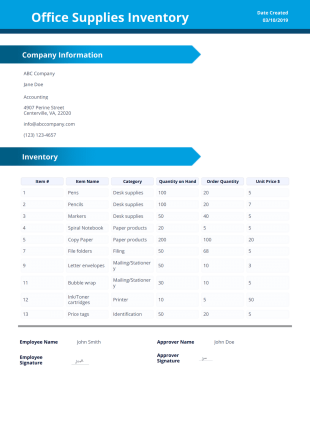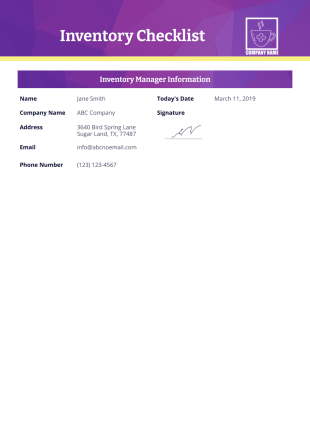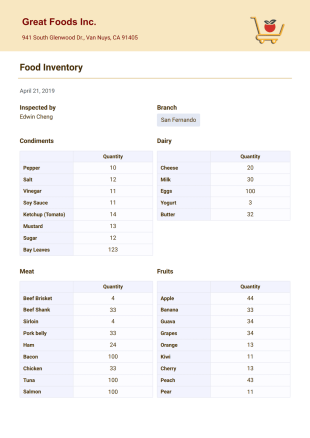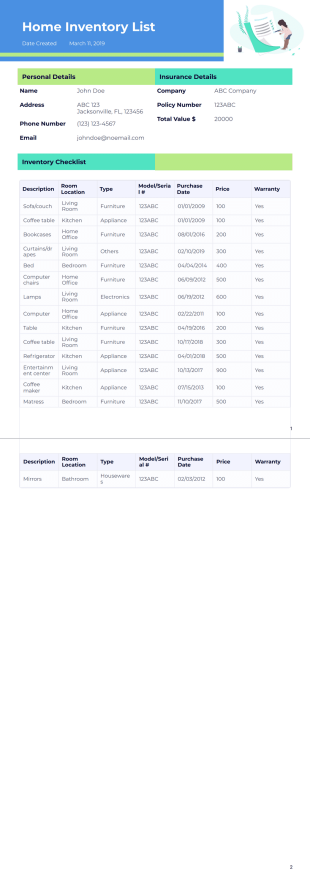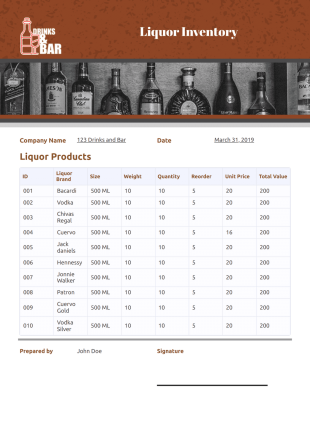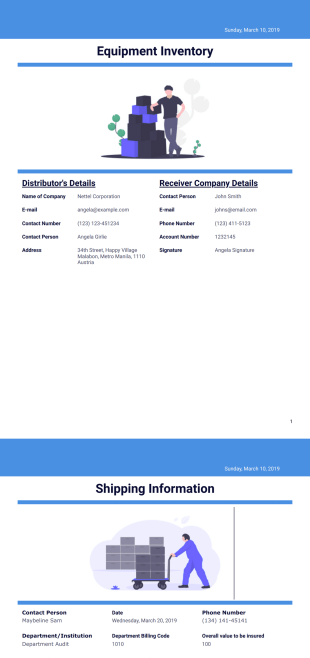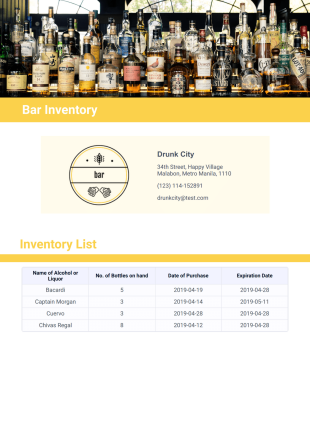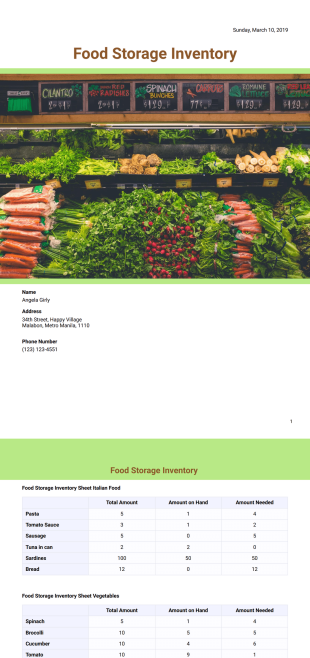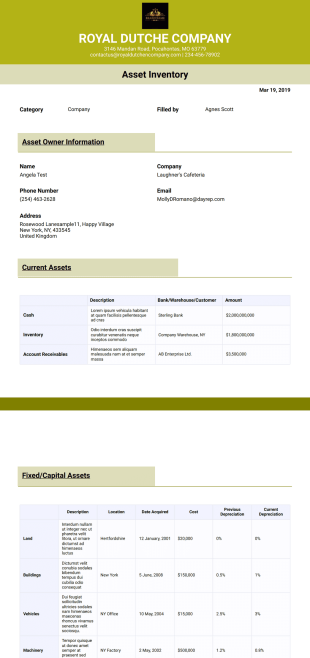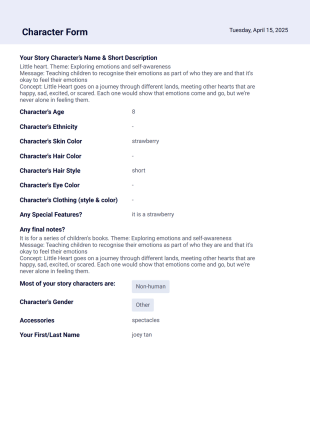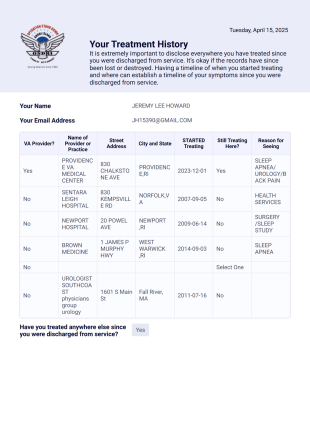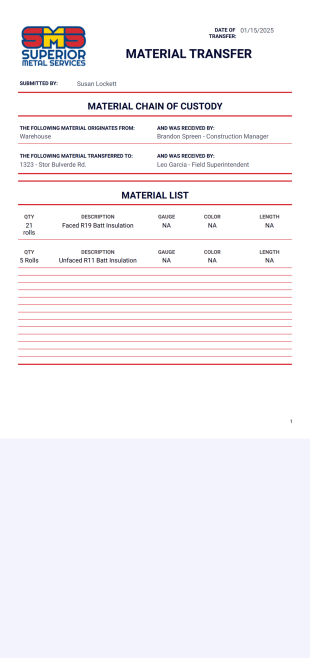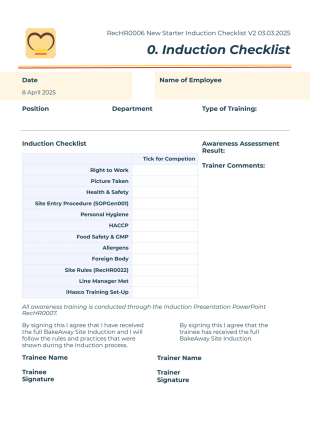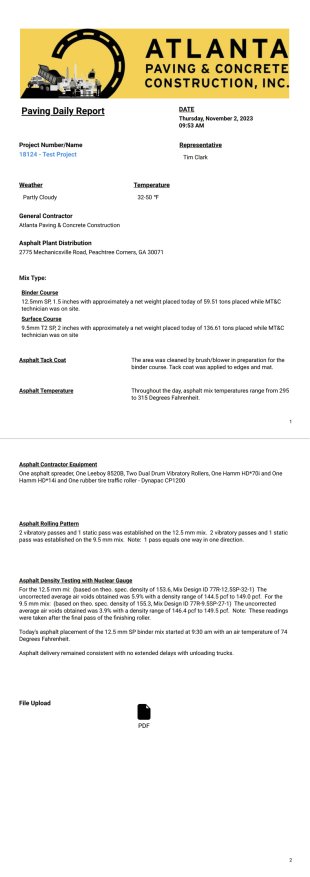Inventory Templates
About Inventory Templates
If you’re still tracking inventory with pen and paper, it’s time to go digital. Jotform lets you quickly and accurately update inventory by product name, quantity on hand, quantity to order, and unit price. When matched to one of our Inventory PDF Templates, submitted information is instantly converted into polished PDFs — easy to download, print, or view on any device.
Whether you’re keeping track of office supplies, restaurant ingredients, or products your company is selling, our Inventory PDF Templates make it easier to manage and order stock. Submissions are converted into professional PDFs, making it easier to track amounts and quickly order from suppliers. And the benefits aren’t limited to businesses — why not use a home inventory template to keep track of the items in your home? The document can even be used for insurance claims.
Since inventory is always changing, an easily customizable tool is a must. Jotform’s drag-and-drop PDF Editor lets you add or remove form fields in a single click. Include your company’s logo and colors, have employees sign their stock takes with an e-signature widget , or link your form to Google Sheets to automatically integrate responses into a spreadsheet. The days of scribbled-down stock takes are over — get your numbers right with one of Jotform’s Inventory PDF Templates.
Frequently Asked Questions
1) What are inventory templates?
Inventory templates are pre-built, digital inventory sheets that help streamline asset tracking. These itemized lists serve as a record of the key assets and materials a business has on hand. They allow workers to track inventory levels, locations, usage, pricing, and more. Businesses can then use this data to identify trends, effectively plan for restocks, avoid waste and overstocking, and increase process efficiency.
Jotform’s collection of free inventory templates gives you the ability to quickly create inventory sheets for a variety of purposes. Whether you own a business, manage an office, work at a bar, or just want to track your groceries, you can create a custom inventory sheet that fits your needs. Customize the design, layout, and item categories in just a few clicks, and download your inventory sheet as a PDF you can share and print for your records.
2) Types of inventory templates
Inventory templates are versatile tools used in a wide range of industries and scenarios. Here are some examples:
- Basic inventory templates are ideal for small businesses or personal use. They’re used to track simple details such as item name, quantity, and price.
- Stock inventory templates are focused on tracking stock levels. They help monitor quantities, reorder points, and restock dates to prevent stockouts and overstocking.
- Medical inventory templates are optimized for healthcare settings. They’re used to manage supplies, medications, and equipment, and they’re particularly useful for tracking expiration dates and usage rates.
- Asset inventory templates are used to manage physical assets like equipment, machinery, or office supplies. They track purchase dates, storage locations, usage rates, and other details.
- Warehouse inventory templates are used to manage inventory in warehouses and often include fields for tracking item locations, bin numbers, and warehouse zones for more efficient storage and retrieval.
- Product inventory templates help businesses track product categories, SKUs, and inventory across different sales channels.
- Raw material inventory templates are used in manufacturing to track the materials required for production, including quantities, lead times, and supplier information.
- Retail inventory templates help workers track inventory across multiple stores and manage reorder levels to maintain optimal stock.
- Sales inventory templates are designed to track products sold so businesses can better monitor trends, manage stock levels, and analyze product performance.
- Consignment inventory templates help consignment businesses track inventory items sent to consignees, monitor sales made, and reconcile consigned inventory to manage payouts.
- IT inventory templates are tailored for managing IT assets such as computers, software licenses, and peripherals. They help track equipment’s location, condition, and maintenance schedule.
- Food and beverage inventory templates are designed to help restaurants and bars track ingredients, beverages, and menu items to minimize waste and ensure the kitchen is always stocked.
- Event inventory templates are ideal for managing items like decorations, equipment, and promotional materials. They help ensure that everything needed for an event is accounted for and ready for use.
- Office supply inventory templates help businesses manage stock levels of items like paper, pens, and printer cartridges to ensure essential supplies are always available.
3) Who uses inventory templates?
Anyone responsible for managing assets and supplies can benefit from using inventory templates to improve organization, cost efficiency, decision-making, and productivity.
Small business owners can use inventory lists to track sales and monitor inventory to ensure that their products are always available but not overstocked. Store managers can use them to manage inventory levels and reorder dates so they can meet customer demand. Chefs, restaurant owners, and kitchen managers can use inventory templates to track ingredients and expiration dates to combat food waste.
Independent makers and entrepreneurs can use inventory templates to keep track of the products they sell online or in person and ensure that they can meet customer demand. Crafters and artisans can track their supply usage to make sure they have what they need to keep creating.
Anyone in charge of planning and hosting events can employ inventory lists to organize supplies such as decorations, equipment, and promotional materials.
Warehouse managers will find these templates useful for tracking stock levels across multiple locations. A well-organized inventory sheet can also help with efficient storage and retrieval of items in a warehouse setting. Manufacturers can monitor raw material levels so materials are reordered in time to avoid disruptions, as well as track finished products so that production runs smoothly.
Logistics coordinators who oversee goods transport can also use inventory templates to ensure that shipments are accurate, on time, and accounted for throughout the supply chain.
IT workers can use inventory sheets to manage assets like computers and software licenses. They can use an inventory template to track equipment locations and manage important details, like warranties. Inventory templates also help property managers track maintenance supplies and equipment across multiple properties.
Healthcare administrators can track medical supplies, medications, and equipment to ensure that essential items are available when needed. School administrators can keep a record of school supplies and books to ensure that classrooms are well-stocked and that resources are available for students and teachers.
Nonprofit organizations can easily manage donations of physical goods and ensure that items are distributed efficiently to those in need.
4) Inventory template use cases
Imagine you are a business owner or store manager. You can use inventory templates to maintain efficient stock levels and make informed decisions that positively impact your bottom line. Record the names, SKUs, and quantities of all your products, then update your inventory sheets periodically to track sales, returns, and new stock received.
You can use this data to identify your best-selling products, as well as when and how much you need to order based on sales patterns and supplier lead times. This helps reduce your risk of running out of popular items — especially during high-demand periods like holidays — and ensures you can meet demand until the next order arrives.
When conducting audits, you may notice that a particular model or color is selling slower than expected. Your inventory data can help you determine when it’s best to run a promotion to clear out inventory and make space for newer models. Your inventory list also helps you manage supplier relationships. If your preferred supplier is consistently late with deliveries, you’ll have the data to negotiate better terms or find an alternative supplier.
In an office setting, you can use an inventory template to determine reorder points that match your team’s actual usage patterns. Start by recording the quantity and location of all your supplies, such as pens, printer paper, and cleaning supplies, then perform weekly checks to update your inventory sheet.
Over time, you’ll notice how fast certain supplies are depleted, and you can decide on a minimum quantity that should trigger a reorder. If printer paper is used frequently in your office, for example, you can set a higher reorder point. By using an inventory list, it’s easy to streamline the reordering process, prevent shortages of essential items, and reduce excess stock.
Inventory templates are also useful for personal needs, such as maintaining a well-stocked kitchen. Take stock of all the pantry staples, produce, and frozen goods you keep in your kitchen, along with when those items were purchased and their expiration dates. You may notice that you have an excess of a certain ingredient, or that another ingredient is nearing its best-by date.
You can use this information to plan meals that incorporate those ingredients so they won’t go to waste. As you use items, you can update your inventory sheet and add the items to your shopping list to ensure you grab them the next time you’re at the store. This also helps you avoid overbuying. By using an inventory list, you can keep your kitchen organized, reduce food waste, and ensure that your pantry, fridge, and freezer are stocked with the items you need and use regularly.

